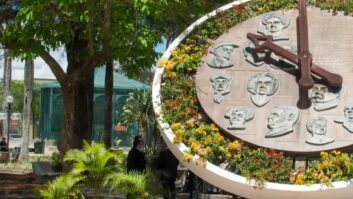Low-power FM proponents expected 2015 to be a key buildout year for holders of construction permits issued from the 2013 filing window; and the expansion of LPFM indeed has led to hundreds of new stations. But some community groups also have struggled to get theirs on the air.
Permittees have ramped up efforts to recruit volunteers and raise money for purchasing equipment, observers told Radio World; but where efforts have failed, a common problem has been underestimating the costs involved. Minimum projected equipment costs of an LPFM startup with new gear vary widely but one source put them at $8,000 to $10,000, even if studio costs and antenna/tower expenses are minimized.
Community groups and nonprofits holding LPFM CPs have 18 months to get their stations on the air from the time the permit is issued, according to the FCC. That can be extended to 36 months upon a showing of “good cause.”
“A permitee requesting an 18-month extension of the original permit must submit a letter to the FCC Secretary, in triplicate, explaining the reason for the extension,” according to the FCC.
The commission’s Audio Division through late August had granted approximately 450 extension requests and cancelled about 100 expired permits from the pool of the 2013 filing window that expired in July and August.

The antenna goes up for WOHM(LP) airing at 96.3 MHz in Charleston, S.C., and licensed to Media Reform South Carolina. Some LPFM efforts never get this far.
credit: Prometheus Radio Project NUMEROUS CHALLENGES
More than 2,800 LPFM applications were filed in the 2013 window, according to REC Networks, a community radio advocate that provides a variety of LPFM services and monitors such data. More than 700 of those were dismissed because of errors and omissions, including technical and paperwork errors as well as applicant requests. This left approximately 2,100 applications to be considered for approval.
From that filing window, approximately 585 new LPFM stations are now licensed, and an additional 1,158 hold CPs, according to REC Networks. The FCC continues to process mutually exclusive applications for contested slots.
As of Sept. 1, a grand total of 1,338 LPFMs were licensed to be on the air, including the 750 or so that predated the recent window.
Some LPFM observers said the commission simplified the 2013 application process to help amateurs and newcomers enter the service. Nevertheless, successful implementation of an LPFM station, not to mention its long-term operation, requires significant expertise and capital.
“LPFM broadcasters face the same obstacles as any other new broadcaster but without the promise of financial reward to warrant taking the necessary risk and committing the necessary resources,” said Peter Gutmann, a telecom attorney with Womble Carlyle Sandridge & Rice, who also contributes to Radio World.
“Some parties discovered they lacked the expertise necessary, whether through inadequate planning or just letting their good intentions get ahead of practical considerations.”
Gutmann said he expects “extensions will be liberally granted by the FCC, given the reduced regulatory requirements and intended purpose of the service.”
Christian Community Broadcasters co-founder John Broomall said any number of reasons could explain why a LPFM permitee would return a CP or allow it to expire, including a loss of interest, higher-than-expected costs and problems with tower site approval.
“In many cases LPFM applications were prepared by third parties. The actual applicants might not even know their CP is expiring or understand the process for getting extended,” Broomall said.
He said CCB submitted a last-minute extension for a permittee in New England that was planning to give up because a full-power station had changed formats to what the LPFM planned to air. In the Pacific Northwest, another permittee gave up because the person who’d had the original vision for the organization left, and the person tasked with getting on the air discovered that the costs — including $18,000 in county permit fees — had been underestimated while projected coverage in a heavily wooded area had been overoptimistic.
One advocate told Radio World that some potential LPFM broadcasters simply lose interest once they learn how limited the signal’s coverage area would be. Low-power FM stations broadcast at a maximum of 100 watts and typically reach a radius of approximately 3-1/2 miles from the antenna. They must be licensed to non-profit entities and often are operated by schools, churches and small community groups.
Sabrina Roach, a community radio advocate for Brown Paper Tickets, said poor organizational development can hurt LPFM hopefuls, but a lack of fundraising ability is likely the biggest hurdle. “I’ve met many savvy and resourceful LPFM applicants, though. They have access to a wide array of public agency and local foundation funding that full-power stations don’t. Full-power community and NPR stations for the most part aren’t eligible for Neighborhood Matching Grants, community technology grants, etc.,” Roach said.
In Seattle, her advocate group found a pool of $9 million in such funding for which LPFMs could qualify. “In total I think they’ve already been granted roughly $80,000 to $100,000 from public agencies.”
Financial and organizational challenges are not new in the LPFM sector. The Low Power FM Advocacy Group believes more than 600 LPFMs have turned in their licenses or CPs since the low-power service launched 15 years ago, though others have disputed that number in comments to the FCC. LPFM-AG blames complicated and burdensome rules; it recently asked the commission to reclassify low-power FM as a primary service, allow expanded sponsorship sales, increase power levels and implement other regulatory changes, as we have reported.
Sanjay Jolly, policy director for Prometheus Radio Project, which builds and supports community stations, said Prometheus does see LPFM attrition but is not surprised by how much.
“There have been some LPFMs who have let their CPs expire; and that steady trickle will likely continue. Organizational priorities change, key staff members move on, etc.,” Jolly said. “We saw the same thing happen in the 2000–2001 LPFM window. It’s not new.
“People are excited to have these stations in their local communities and to contribute to their success. Despite some growing pains, we’re seeing the promise of LPFM being realized in towns and cities across the country,” Jolly said. He cited the example of two organizations with which Prometheus has worked recently — a community health LPFM in New Orleans and a Native American tribal station in California — saying both employ realistic budgeting practices.
COSTLY EFFORT
Radio World reached out to a number of non-profit groups with expired CPs to ask about their circumstances but the vast majority did not respond. Several that did were hesitant to discuss their individual situations. LPFM observers were not surprised to learn of this reluctance.
“Most of the groups that haven’t been able to execute their CP don’t really want to be public about why,” said Tracy Rosenberg, executive director of Media Alliance.
Russell Johnson, founder of Fremont County Community Radio Inc., said the group relinquished its CP earlier this year after being displaced from its planned antenna site. Johnson said he’d exhausted his personal funds budgeted to build the radio station.
Johnson, who has a commercial radio background, had hoped the low-power radio station planned for Cañon City, Colo., near Colorado Springs, would become a laboratory for area high school and college students to explore broadcasting. The LPFM radio station would play a mainstream music format and be highly automated.
“Cañon City, while within the service contours of most Colorado Springs/Pueblo radio stations, is shadowed by foothills and mountains so most signals that don’t originate here in the Arkansas River valley end up being a scratchy, multipathed mess,” he said.
Johnson joined the local Chamber of Commerce; he also launched a Facebook page and a GoFundMe campaign to drive his fundraising efforts. “I spent $200 to incorporate my community organization, but did my own engineering work, which limited my expenses.”
When Johnson learned the owners of the tower where he planned to locate his LPFM reactivated a FM translator, taking the last available slot, the daunting task of doing new engineering work and moving to a new channel were overwhelming.
“I could have used my own funds to build the station, but with a daughter getting ready to enter college next year, I decided that what limited funds I had needed to go for helping with her tuition,” Johnson said.
Confusion about rules may also contribute. Engineer Kyle Magrill mentioned an experienced client who had been struggling to fulfill the “points criteria” under which they’d successfully applied to change from a time-share to a full-time station. He said the station board was under the mistaken belief that it had to fulfill the points criteria, building and staffing studios immediately. But because its application had been a “singleton” with points criteria not coming into play, he said, the station in fact was not obligated to fulfill those commitments.
“They can now concentrate on buying the equipment that they actually will need,” Magrill wrote in an email. “I wonder how many other singleton applicants are laboring under the same misconceptions.”
Another LPFM permitee, Growing Gardens — an organic gardening group in Portland, Ore., that builds raised vegetable gardens throughout the community — lacked the internal capacity and community partners to move forward, according to David Greenberg, its executive director. “We returned our construction permit,” Greenberg told Radio World in an email.
LPFM proponents still believe many more new LPFMs eventually will be on the air as a result of the application filing window in 2013, as many as 1,800 total by some estimates.
How many LPFMs actually get built, survive and thrive? How many become community institutions? Has LPFM achieved what its backers hoped for it? Comment on this or any story. Email[email protected], attention Letter to the Editor.





